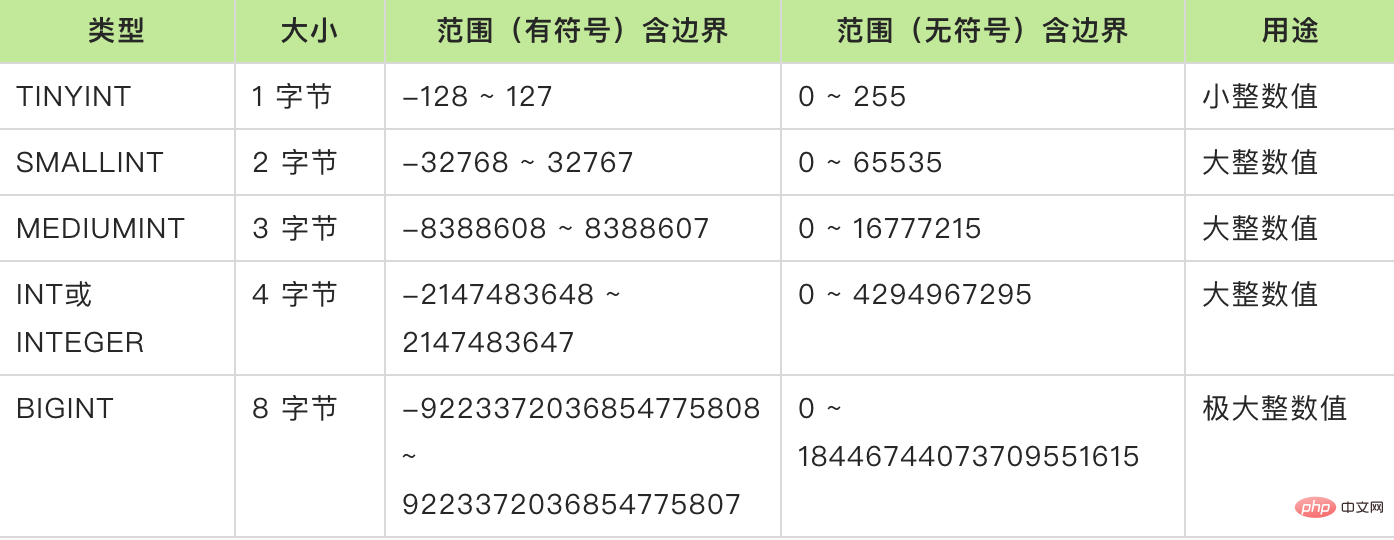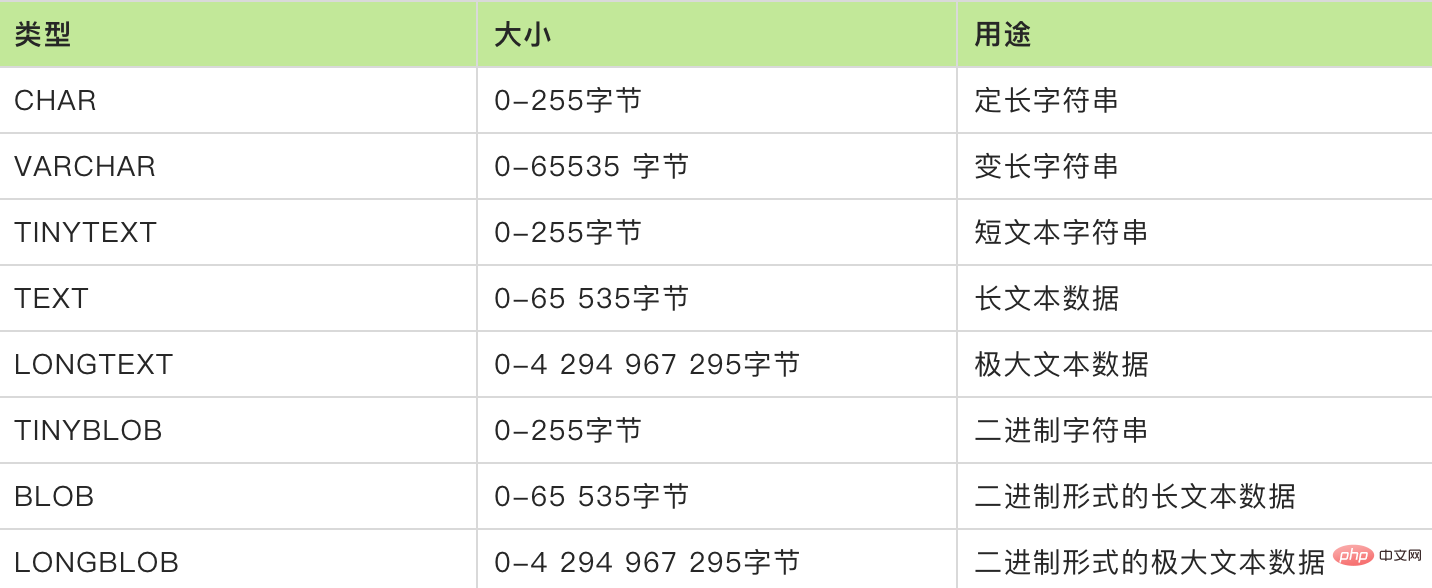The most complete analysis: MySQL field types
This article brings you relevant knowledge about mysql field types and makes a summary. I hope it will be helpful to everyone.

Foreword:
To understand a database, we must understand the data types it supports. MySQL supports a large number of field types, many of which are commonly used. We have also talked about the usage of int and varchar types in previous articles, but we have never fully talked about field types. In this article, we will cover all field types and talk about the usage of common field types.
Commonly used field types can be roughly divided into three categories: Numeric type, String type, Date time type. Below we classify Let’s introduce them in turn.
1. Numerical type
The main categories of numerical types can be divided into integer type,floating point type,fixed point typeThree small categories.
Integers are mainly used to store integer values. There are mainly the following field types:

Integers are often used, such as tinyint, int, bigint. The default is signed. If you only need to store unsigned values, you can add the unsigned attribute.
The M in int(M) represents the maximum display width. It does not mean that int(1) cannot store the value 10. No matter how many characters the display width is set, int will occupy 4 characters. section, that is, the storage range of int(5) and int(10) is the same.
The smaller the storage bytes, the smaller the space occupied. Therefore, in line with the principle of minimizing storage, we should try to choose the appropriate integer type. For example, tinyint can be used to store some status values or people's ages; for primary key columns, there are no negative numbers. It is recommended to use int unsigned or bigint unsigned to estimate field numbers. The value will exceed 4.2 billion, using the bigint type.
Floating point types mainly include float and double. Floating point types store approximate values in the database, such as float(6,3). If you insert a number 123.45678, the actual value stored in the database is 123.457. However, the total number is subject to actual conditions, that is, 6 digits, and the maximum integer part is 3 digits. float and double are not commonly used.

#There is one fixed-point field type: DECIMAL, which is mainly used to store decimals with precision requirements.

DECIMAL was introduced from MySQL 5.1, and the column declaration syntax is DECIMAL(M,D). NUMERIC is synonymous with DECIMAL. If the field type is defined as NUMERIC, it will be automatically converted to DECIMAL.
For the declaration syntax DECIMAL(M,D), the value range of the argument is as follows:
- M is the maximum number of digits (precision), and the range is 1 to 65. Can not be specified, the default value is 10.
- D is the number of digits to the right of the decimal point (decimal places). The range is 0 to 30, and cannot be larger than M. It does not need to be specified. The default value is 0.
For example, the field salary DECIMAL(5,2) can store any value with five digits and two decimal places, so the range of values that can be stored in the salary column is from -999.99 to 999.99 .
2. String type
The string type is also often used. The commonly used types are as follows:

where char and varchar are the most commonly used. The char type is fixed-length, and MySQL always allocates enough space according to the defined string length. When char values are saved, they are padded to the right with spaces to the specified length, and when char values are retrieved, trailing spaces are removed. The varchar type is used to store variable-length strings. During storage, if the characters do not reach the defined number of digits, spaces will not be added at the end.
The M in char(M) and varchar(M) represents the maximum number of characters saved. A single letter, number, Chinese, etc. all occupy one character. char is suitable for storing very short strings, or when all values are close to the same length. For example, char is ideal for storing the MD5 value of a password because it is a fixed-length value. For situations where the string is very long or the strings to be stored are of different lengths, varchar is more suitable.
When defining the maximum length of a field, we should allocate it as needed, make an estimate in advance, and try not to use the text type if the varchar type can be used. Unless there is a need to store long text data, consider using the text type.
The BLOB type is mainly used to store binary large objects, such as pictures, audio and video files. Rarely used in daily life, you can consider using it when storing binary strings.
3. Date and time types
The date and time types supported by MySQL are YEAR, TIME, DATE,DATETIME, TIMESTAMP, several types are compared as follows:

When it comes to date and time field type selection, just select the appropriate type according to storage requirements.
How to choose between DATETIME and TIMESTAMP types can be based on storage requirements. For example, if a wider storage range is required, it is recommended to use DATETIME. If you only store the current timestamp, you can use the TIMESTAMP type. However, it is worth noting that TIMESTAMP field data will change with the system time zone but DATETIME field data will not. In general, DATETIME is more widely used.
Summary:
This article mainly introduces the commonly used field types in MySQL. The field types commonly used are basically here, with a thinking guide The figure is summarized as follows:

Recommended learning: mysql video tutorial
The above is the detailed content of The most complete analysis: MySQL field types. For more information, please follow other related articles on the PHP Chinese website!

Hot AI Tools

Undresser.AI Undress
AI-powered app for creating realistic nude photos

AI Clothes Remover
Online AI tool for removing clothes from photos.

Undress AI Tool
Undress images for free

Clothoff.io
AI clothes remover

Video Face Swap
Swap faces in any video effortlessly with our completely free AI face swap tool!

Hot Article

Hot Tools

Notepad++7.3.1
Easy-to-use and free code editor

SublimeText3 Chinese version
Chinese version, very easy to use

Zend Studio 13.0.1
Powerful PHP integrated development environment

Dreamweaver CS6
Visual web development tools

SublimeText3 Mac version
God-level code editing software (SublimeText3)

Hot Topics
 MySQL: An Introduction to the World's Most Popular Database
Apr 12, 2025 am 12:18 AM
MySQL: An Introduction to the World's Most Popular Database
Apr 12, 2025 am 12:18 AM
MySQL is an open source relational database management system, mainly used to store and retrieve data quickly and reliably. Its working principle includes client requests, query resolution, execution of queries and return results. Examples of usage include creating tables, inserting and querying data, and advanced features such as JOIN operations. Common errors involve SQL syntax, data types, and permissions, and optimization suggestions include the use of indexes, optimized queries, and partitioning of tables.
 MySQL's Place: Databases and Programming
Apr 13, 2025 am 12:18 AM
MySQL's Place: Databases and Programming
Apr 13, 2025 am 12:18 AM
MySQL's position in databases and programming is very important. It is an open source relational database management system that is widely used in various application scenarios. 1) MySQL provides efficient data storage, organization and retrieval functions, supporting Web, mobile and enterprise-level systems. 2) It uses a client-server architecture, supports multiple storage engines and index optimization. 3) Basic usages include creating tables and inserting data, and advanced usages involve multi-table JOINs and complex queries. 4) Frequently asked questions such as SQL syntax errors and performance issues can be debugged through the EXPLAIN command and slow query log. 5) Performance optimization methods include rational use of indexes, optimized query and use of caches. Best practices include using transactions and PreparedStatemen
 Why Use MySQL? Benefits and Advantages
Apr 12, 2025 am 12:17 AM
Why Use MySQL? Benefits and Advantages
Apr 12, 2025 am 12:17 AM
MySQL is chosen for its performance, reliability, ease of use, and community support. 1.MySQL provides efficient data storage and retrieval functions, supporting multiple data types and advanced query operations. 2. Adopt client-server architecture and multiple storage engines to support transaction and query optimization. 3. Easy to use, supports a variety of operating systems and programming languages. 4. Have strong community support and provide rich resources and solutions.
 How to connect to the database of apache
Apr 13, 2025 pm 01:03 PM
How to connect to the database of apache
Apr 13, 2025 pm 01:03 PM
Apache connects to a database requires the following steps: Install the database driver. Configure the web.xml file to create a connection pool. Create a JDBC data source and specify the connection settings. Use the JDBC API to access the database from Java code, including getting connections, creating statements, binding parameters, executing queries or updates, and processing results.
 How to start mysql by docker
Apr 15, 2025 pm 12:09 PM
How to start mysql by docker
Apr 15, 2025 pm 12:09 PM
The process of starting MySQL in Docker consists of the following steps: Pull the MySQL image to create and start the container, set the root user password, and map the port verification connection Create the database and the user grants all permissions to the database
 MySQL's Role: Databases in Web Applications
Apr 17, 2025 am 12:23 AM
MySQL's Role: Databases in Web Applications
Apr 17, 2025 am 12:23 AM
The main role of MySQL in web applications is to store and manage data. 1.MySQL efficiently processes user information, product catalogs, transaction records and other data. 2. Through SQL query, developers can extract information from the database to generate dynamic content. 3.MySQL works based on the client-server model to ensure acceptable query speed.
 Laravel Introduction Example
Apr 18, 2025 pm 12:45 PM
Laravel Introduction Example
Apr 18, 2025 pm 12:45 PM
Laravel is a PHP framework for easy building of web applications. It provides a range of powerful features including: Installation: Install the Laravel CLI globally with Composer and create applications in the project directory. Routing: Define the relationship between the URL and the handler in routes/web.php. View: Create a view in resources/views to render the application's interface. Database Integration: Provides out-of-the-box integration with databases such as MySQL and uses migration to create and modify tables. Model and Controller: The model represents the database entity and the controller processes HTTP requests.
 How to install mysql in centos7
Apr 14, 2025 pm 08:30 PM
How to install mysql in centos7
Apr 14, 2025 pm 08:30 PM
The key to installing MySQL elegantly is to add the official MySQL repository. The specific steps are as follows: Download the MySQL official GPG key to prevent phishing attacks. Add MySQL repository file: rpm -Uvh https://dev.mysql.com/get/mysql80-community-release-el7-3.noarch.rpm Update yum repository cache: yum update installation MySQL: yum install mysql-server startup MySQL service: systemctl start mysqld set up booting






